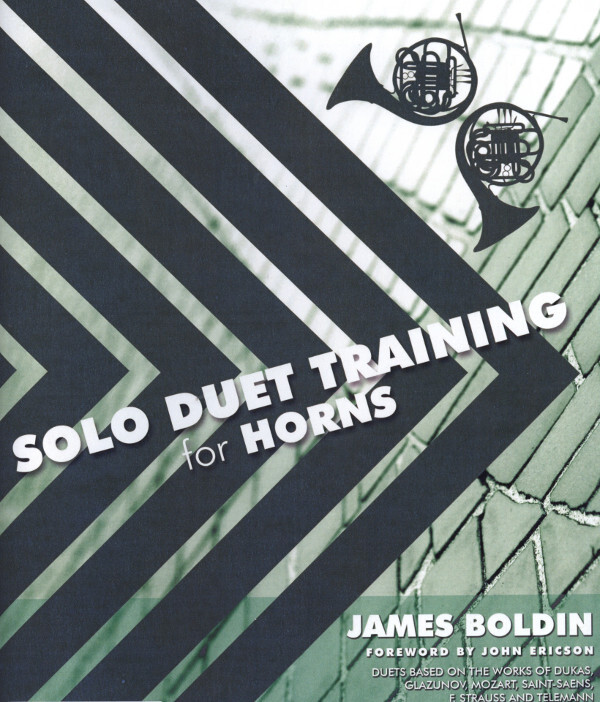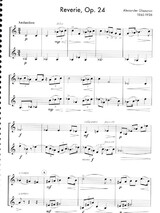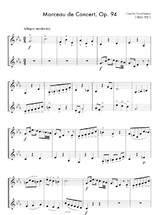Solo Duet Training for Horns - Spielpartitur
für 2 Hörner
 Mountain Peak Music Mountain Peak MusicStil:
Mountain Peak Music Mountain Peak MusicStil:  MusicalAusgabe: NotenArt-Nr.: Z2511 / MPM 11-026 Level:
MusicalAusgabe: NotenArt-Nr.: Z2511 / MPM 11-026 Level:
Solo Duet Training for Horns by James Boldin is appropriate for high school through professional horn players.
These duets are a unique and creative way to learn seven of the most popular horn solos. Solo Duet Training can be used to help students learn style and technique, as recreational musical diversions, or even as additions to recitals if an accompanist is unavailable. The duets include Villanelle by Dukas, Reverie by Glazunov, Concerto K. 447 (Horn in F and E-flat) by Mozart, Morceau de Concert and Romance by Saint-Saens, Nocturno by F. Strauss, and Concerto (Horn in F and D) by Telemann.
With this truly creative book of Solo Training Duets, James Boldin adds yet another useful and, in this case in particular, enjoyable new dimension to the repertoire for advancing horn students and their teachers. His clever and effective manipulation and extraction of the melodic and harmonic materials found in the piano and orchestral scores of seven of the most popular horn solos provides us the fun of duet playing. And in doing so, we actually learn, first hand, significant compositional content, expanding our understanding and appreciation for these important composers intentions. Thank you James for this innovative contribution, and for continuing to make the art and the act of horn playing ever more enjoyable. Douglas Hill, Emeritus Professor of Horn, UW-Madison
From The Horn Call October, 2015:
James Boldin, Associate Professor of Horn at the University of Louisiana at Monroe, has had several arrangements reviewed in The Horn Call recently, and in this latest publication he has taken his arranging skills to the next level. We are presented with a set of "solo duets" based on Dukas' Villanelle, Glazunov's Reverie, op. 24, Mozart's Concerto in E-flat K. 447, Saint-Saens' Romance, op. 36, and Morceau de Concert, op. 94, Franz Strauss' Nocturno, op. 7, and Telemann's Concerto in D, TWV 51D:8.
This unique approach combines the solo horn part with choice parts of the accompaniment such that harmonies are preserved, or at least implied, and intervening melodies and transitions are somewhat preserved. But this is not simply one part on the tune and the other on the accompaniment. In his Introduction, Boldin explains the difference: "Solo and accompaniment passages are evenly divided, and both parts are similar in difficulty." The result is an advanced set of technical challenges for the players. Of course, not every note of the accompaniment is accounted for, but in many instances the accompaniment is actually more difficult technically than the solo part.
I do like the concept and we did have some fun in reading sessions navigating the trading of parts and contending with moving directly from solo to accompaniment and vice versa. Boldin has built in some wise aspects, too: periods of rest for one voice where a melody dominates in the other, and several pauses with breaks in longer movements, omitting a few sections that would not be practical in range or technique; e.g., the first fast piano passage in Villanelle, the opening exposition and the middle transition in the first movement of Mozart's K. 447, among a few others. Boldin also includes parts in both F and E-flat/D for the pieces by Mozart and Telemann, respectively, to encourage transposition from original notation. Boldin suggests that players consider performing these duets as well, and, while I am not yet convinced of this, I think some of them could work, at least those that do not have sections omitted. There is no doubt, however, that players who can manage the ranges and the relatively continuous playing will enjoy the challenges offered by these new versions of old favorites.
Playing duets can be both fun and instructive, and these arrangements definitely fit the description. Mountain Peak Music has additional volumes of these types of duets for other instruments as well. JS
Two parts, each 42 pages, stapled







